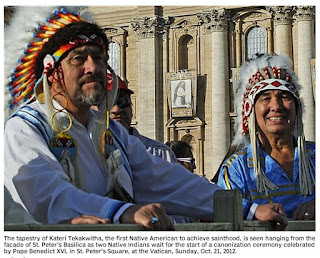It is good that No Doubt released a statement today, stating that you never intended to offend, hurt, or trivialize Native American people, culture, or history. I understand that you consulted with Native friends and experts at the University of California. Unfortunately, your consultants didn't give you good advice.
It is good that you removed the video and posted the apology, but given your status, you could do a lot more that has the potential to prevent millions from making the sort of error you made.
Ms. Stefani, please make another video...
Make another video. Not a music one, but one in which you speak directly to your fans, telling them that Americans have a long way to go in understanding what stereotypes of American Indians are, and the ignorance and racism they perpetuate.
Make that video right away. It doesn't need slick production values. Make it right away so that teachers across the nation can use it this month! November is Native American Heritage Month. Teachers and librarians could use it to teach teens about American Indians and stereotyping.
Thank you,
Debbie Reese
American Indians in Children's Literature
----------
For those who want background information, here's one photo that was used to promote the video. Regular readers of American Indians in Children's Literature will easily spot the stereotypical aspects of the photo.
 |
| Source: Daily Mail http://goo.gl/3r25F |
Regular readers will also spot multiple stereotypes in the article the photo came from:
"Yeehaw! Gwen Stefani dresses as a Native American, cavorts with a wolf, and ends up handcuffed in No Doubt's new Wild West themed music video." In the article, Eleanor Gower reports that Stefani "dresses as a Native American Squaw." There are lot of photos there, with many other stereotypes. See, for example, Stefani doing smoke signals.
Here's a background article from November 2, 2012:
"Gwen Stefani and No Doubt Release Latest Music Video, Its Stereotypical Native Theme Garners Criticism" in Indian Country Today Media Network.
And here's a blog post from Scott Andrews, a Native lit professor:
"Gwen Stefani, Cher, and "Indians"
And.... here's the apology from No Doubt:
In Regards to Our "Looking Hot" Music Video
Posted 11/3/2012 |As a multi-racial band our foundation is built upon both diversity and consideration for other cultures. Our intention with our new video was never to offend, hurt or trivialize Native American people, their culture or their history. Although we consulted with Native American friends and Native American studies experts at the University of California, we realize now that we have offended people. This is of great concern to us and we are removing the video immediately. The music that inspired us when we started the band, and the community of friends, family, and fans that surrounds us was built upon respect, unity and inclusiveness. We sincerely apologize to the Native American community and anyone else offended by this video. Being hurtful to anyone is simply not who we are.- No Doubt


































